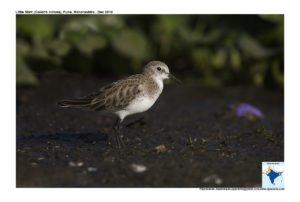Little Stint

Little Stint Calidris minuta
Etymology:
- Calidris : Greek word for grey-coloured waterside bird mentioned by Aristotle
- Minuta : Latin word for “small, little”
Vernacular Names: Baluchistan: Tanki, Hindi: Chhotapan lowwa, Pun:Panlawa, Bi: Runni, Guj: Kichadiyo, Kalapagkhi chdiyo, nanokhi chdiyo, Mar: Chhotapan lawa/Tilawa, ChotiChikhalitutari, Ta: Kosuullan
Distribution in India: Widespread winter visitor in India
Description: Size of 13-15 cm.It is a tiny, compact stint with short bill; feathers of upperparts have dark brown centers and pale rufous fringes or tips; mantle with yellowish edges forming distinct “V”; head, neck and breast rufous buff with brown streaks; rest of underparts, throat and chin white. White throat, dark streaks on sides of neck and breast. Both sexes similar but female is larger. Non-breeding adult has brownish grey upperparts mottled dark and fringed pale; crown grey, streaked dark; eyestripe and sides of breast dull grey; rest of face and underparts white.
Habitat: It is found during breeding in Tundra of high Arctic. On migration found at small inland waters and riverbanks, or coastal, on mudflats and seashore. In winter quarters mainly coastal, at estuarine mudflats, enclosed lagoons, tidal creeks; also at inland fresh waters, such as open pools in marshes, paddy fields,
Food Habits: It eats invertebrates; during breeding season primarily larval and adult Diptera and small beetles; after breeding also ants, Hymenoptera, water-bugs, annelids, small molluscs, crustaceans, freshwater mites and plant material. It feeds by rapid pecking actions, sometimes probes; detects prey by sight. It gregarious, in small to large flocks, up to several thousand birds; sometimes defends feeding territory
Breeding Habits: They breed in Arctic Europe and Asia in June-July. They are monogamous, polygynous or polyandrous. Loosely territorial, with no clearly defined area defended; little or no fidelity to breeding site. Nest on ground, exposed, but sometimes covered by vegetation, and lined with leaves and pieces of grass. They lay a clutch of 3-4 eggs. The incubation period is 20–21 days, by both parents, but in cases of polygamy by male or female only; polyandrous females may incubate a second clutch. Chick-care by one parent.